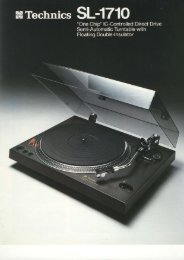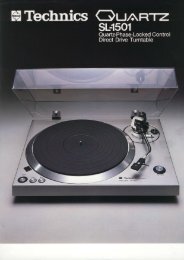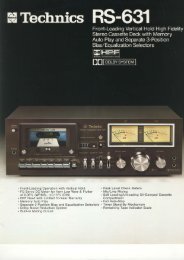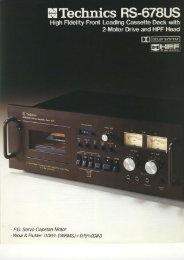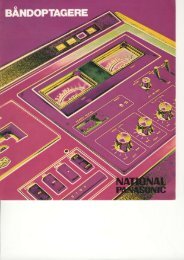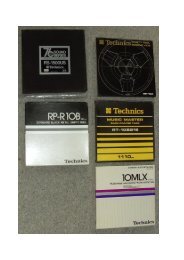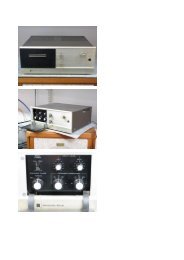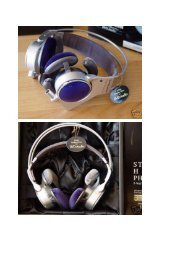You also want an ePaper? Increase the reach of your titles
YUMPU automatically turns print PDFs into web optimized ePapers that Google loves.
3<br />
o<br />
l"l rl<br />
n 99<br />
g!!<br />
**':*".1,=;;;|<br />
,:[1,,<br />
r€Tery<br />
::!::r,r:;,;Ji<br />
The serious music lover wants an audio system that<br />
will reproduce the original musical performance<br />
with as much fidelity as possible. Each component<br />
must either pass signals without adding coloration,<br />
or must provide just the right amount of compensation<br />
to previously modified signals. The SU-7700<br />
performs these functions beautifully. While its<br />
most apparent attributes are excellent specifications<br />
and elegant styling, it can be fully appreciated<br />
only when heard with other components of equally<br />
high quality. The transparent and "effortless"<br />
rendition of very demanding program material<br />
will delight even the most critical listener.
50 watts per channel, minimum RMS, both channels driven, at 8 ohms<br />
from 2OHz to 2O kHz,with no more than O.O8o/o total harmonic distortion.<br />
At 1,OOOHz, this figure rises to S3watts per channel at 8ohms.<br />
Power When You Need lt-Fidelity Always<br />
50 watts per channel, minimum RMS, both<br />
channels driven, at 8 ohms, from 20 Hz to<br />
2Q kHz, with no more than 0.08% total<br />
harmonic distortion. That says it in a<br />
nutshell, but have you considered what<br />
this performance means for practical<br />
listening enjoyment? SuPPose Your<br />
speakers are low-efficiency, or that you<br />
want to drive two pairs at once. Suppose<br />
your musical tastes run to popular music<br />
irvitn a lot of floor-shaking low bass'<br />
Under most conceivable home listening<br />
situations, the SU-7700 will provide all<br />
the power you need. But the real<br />
accomplishment of Technics engineers<br />
has been to hold total harmonic distortion<br />
down to 0.08%, and to control this rather<br />
awesome power right down through the<br />
lowest audible lrequencies, so power<br />
bursts won't create transient distortion<br />
that can momentarily degrade fidelity.<br />
Combined with other components ot equal<br />
oualitv, vour SU-7700 will provide power<br />
virnen'it's needed, and muiical fidelity all<br />
the time.<br />
Current Mirror Loading Attains Extremely High S/N Ratio in Equalizer and Low Distortion<br />
in Power Circuits<br />
A classic dilemma in amplifier design is to By virtue of current mirror loading, the<br />
achieve higher operating current (for gain) gain producing effect of a given operating<br />
without a correspondingly higher level current is magnified. The results are a<br />
of noise. To solve this problem, Technics higher S/N ratio in the equalizer and a<br />
has employed current mirror loading in lower distortion rating in the power<br />
the dilferential amplifier first stage of the amplif ier.<br />
equalizer circuit and the power amplifier.<br />
78dB<br />
S/N Ratio al 2.5 mV Phono lnput<br />
Sensitivity<br />
The 78 dB phono signal-to-noise ratio is<br />
the equivalent of a 1/8,0001h noise<br />
component in the music signal. In real<br />
terms, this means that on well cared-for<br />
records, noise won't interfere with your<br />
enjoyment of the music, even during very<br />
soft passages. Significantly, the S/N ratio<br />
should be even better than 78 dB with<br />
high output cartridges, as this figure was<br />
obtained at a relatively high sensitivity<br />
level of 2.5 mV.<br />
This extreme<br />
"quietness" of the<br />
phono equalizer is<br />
the result of<br />
advanced current ffi,:'"<br />
mirror circuit<br />
design and<br />
use of low<br />
noise lC.<br />
0.08%<br />
Total Harmonic Distortion<br />
(20 Hz-20 kHz) at Rated oulput<br />
In hi gh-f idelity amplif iers, only distortionfree<br />
power counts. At any power level,<br />
from a whisper to the roar of the full<br />
50 watts per channel, the total harmonic<br />
distortion of the SU-7700 never exceeds<br />
an imperceptible 0.08%, and is typically<br />
much less. Note, too, that this also applies<br />
to the entire range of frequency response,<br />
from 20 Hz to 2O kHz. Use of matched<br />
transistor pairs in a single package and<br />
already mentioned<br />
current mrrror<br />
loading contribute to<br />
this low distortion<br />
f igure.<br />
Single packaged pair<br />
transistor
Subsonic Equalizer Filter<br />
A subsonic f ilter in the NFB loop of the<br />
phono equalizer removes inaudible but<br />
nevertheless troublesome ultra-low<br />
frequencies which could cause intermodulation<br />
distortion in conventional<br />
circuits. Rumble, low-frequency noise<br />
resulting f rom warped records, as well as<br />
tonearm/cartridge resonances are cut off<br />
at the source with a steep 12 dB/oct slope<br />
below 30 Hz. Typically, a resonance peak<br />
of the tonearm/cartridge assembly appears<br />
in the 5 Hz to 10 Hz area, as shown below.<br />
It is clearly noticeable as a useless<br />
"pumping" movement of the woofer cone.<br />
Cut-off at the input means that such<br />
subsonic "garbage" can do no harm at any<br />
downstream signal stage. Conventional<br />
subsonic filters, on the other hand, are<br />
inserted into the preamplif ier after much<br />
of the intermodulation has alreadv been<br />
generated.<br />
RIAA Gompensation Accurate Within<br />
*0.2 dB<br />
The playback equalization characteristic<br />
of the SU-7700 varies by only +0.2 dB<br />
(30 Hz-15 kHz) from being a perfect<br />
inverse of the RIAA recording characteristic<br />
for phonograph records. In the past,<br />
precision of this order would have been<br />
difficult to find even in very eixpensive<br />
amplifiers. We achieved it through use of<br />
+1ok tolerance metallic f ilm resistors and<br />
+2o/o polypr opylene capacitors.<br />
Two-Way Dubbing<br />
The tape selector circuit permits two tape<br />
decks to be connected at the same time to<br />
the SU-7700. Dubbing may be performed<br />
between the two decks in either direction.<br />
Additionally, as the tape monitor and<br />
recording mode switches operate<br />
independently, you can use the SU-7700 to<br />
listen to a record or FM program while<br />
tape dubbing is in progress.<br />
41 Step Volume Control<br />
To provide precise, repeatable volume<br />
settings, the volume control has 41 clicksrops.<br />
Tone Controls with Deleat at "0" Position<br />
Using-newly developed controls, the bass<br />
and treble control circuits are disconnected<br />
lrom the main circuits when the respective<br />
control knob is set at the center ("0")<br />
position. ln this state, the main circuit is<br />
reduced to an equalizer amplifier, plus a<br />
power amplifier- the simplest possible<br />
circuit, and one in which potential sources<br />
of distortion are minimized. When the<br />
tone controls are used, their negative<br />
feedback circuits provide low distortion<br />
equalization that would be considered<br />
excellent by any standards. With these<br />
controls, equalization is variable over a<br />
wide range of +12 dB.<br />
High Filter<br />
Cuts out high frequency noise such as<br />
record scratches and taoe hiss.<br />
Direct Reading Power Meters<br />
The large scale meters provide direct<br />
readout (at 8 ohms) of amplifier output<br />
power in watts, with instantaneous tracing<br />
of signal peaks. To improve linearity at<br />
low output, a germanium diode is used for<br />
rectification. Two ranges are provided<br />
(x1 and x0.1) for accurate monitoring of<br />
all output levels.<br />
Muting Circuit Eliminates Power On/Off<br />
Switching Noise<br />
To eliminate the unpleasant noises which<br />
are heard from the speakers when power<br />
is turned on or off, the SU-7700 is<br />
equipped with a muting relay which<br />
operates in conjunction with a protective<br />
circu it.<br />
Stabilized Power Supply<br />
To insure that adequate power, at constant<br />
voltage, is available for every output<br />
requirement, the SU-7700 features a<br />
balanced positive-negative power supply<br />
using transistors and zener diodes.<br />
Main/Remote Speaker Facililies<br />
Two pairs of speakers may be connected<br />
and fed separately or together. Two<br />
pushbutton selectors permit operation of<br />
main speakers only, remote speakers<br />
only, or'both pairs simultaneously.<br />
Heat sinks<br />
Electrolytic capacitor<br />
10,000aFx2<br />
Power transistors<br />
Power transformer<br />
Protection relay and<br />
pop noise muting circuit<br />
Current mirror loaded<br />
differential amplif ier<br />
Low noise phono equalizer circuit
1. Power on/olf switch<br />
2. Phones jack<br />
3. Main sDeaker switch<br />
4. Remote speakers switch<br />
5. Meter range seleclor<br />
6. High filter switch<br />
7. Loudness switch<br />
8. Bass control<br />
9. Treble control<br />
Technical Specifications<br />
10. Mode selector<br />
11. Rec/Mode selector<br />
12. Taoe monitor switch<br />
13. Inout selector<br />
14. Equalizer subsonic lilter switch<br />
15. Volume control<br />
16. Balance control<br />
17. Direct reading power meters<br />
'1.<br />
Ground terminal<br />
2. Phono inputs<br />
3. Tuner inputs<br />
4. AUX inputs<br />
5. Tape deck 1, REC outputs<br />
6. Tape deck .1, PLAY inputs<br />
7. Tape deck 2, REC outputs<br />
8. Tape deck 2, PLAY inPuts<br />
9. REC/PLAY terminal<br />
(tape deck 2)<br />
10. SDeaker terminals (main)<br />
11. Soeaker terminals (remote)<br />
AMPLIFIER SECTION<br />
1 kHz continuous power output<br />
both channels driven 2 x 70W (4o)<br />
2x53W (8o)<br />
40 Hz-16 kHz continuous power output<br />
both channels driven 2x60W (4o)<br />
2x50W (8o)<br />
20 Hz-20 kHz continuous power output<br />
both channels driven 2 x 60W (4o)<br />
2x50W (8o)<br />
Power bandwidth<br />
both channels driven at 4rl<br />
I Hz-55 kHz, -3 dB<br />
Total harmonic distortion<br />
rated power at 40 Hz-16 kHz, 4a 0.08%<br />
rated power al 1 kHz,4a 0.08%<br />
-26 dB power at 1 kHz,4a 0.1%<br />
50 mV power at 1 kHz, 4a 0.15%<br />
lntermodulation distortion<br />
rated power at 250 Hzi I kqz=4:1, 4a<br />
0.08%<br />
Frequency response<br />
5 Hz-80 kHz, -3 dB<br />
10 Hz-40 kHz, - 1 dB<br />
Damping factor<br />
50 (8o), 25 (4o)<br />
Input sensitivity & impedance<br />
PHONO<br />
2.5mV147 ka<br />
TUNER<br />
150mV/47 ko<br />
AUX<br />
150mV/47 kfl<br />
PLAYBACK, TAPE 1 180mV/47 ko<br />
PLAYBACK. TAPE 2 150mV/47 ko<br />
REC/PLAY, TAPE 1,2 180mV/47 ko<br />
PHONO maximum input voltage<br />
150mV<br />
(1 kHz, RMS)<br />
s/N<br />
rated power PHONO<br />
AUX<br />
-26 dB power PHONO<br />
AUX<br />
50 mW power PHONO<br />
AUX<br />
63 dB<br />
83 dB<br />
55 dB<br />
58 dB<br />
53 dB<br />
53 dB<br />
Tone controls<br />
BASS 50 Hz, +12 dB--12 dB<br />
TREBLE 20 Hz, +12 dB__12 dB<br />
EQ subsonic filter 30 Hz, -12 dB/oct<br />
High filter<br />
8 kHz, -6 dB/oct<br />
Loudness control (volume at -30 dB)<br />
'100<br />
Hz, *8 dB<br />
Output voltage & impedance<br />
REC OUT, TAPE 1, 2 150mV/1.2ka<br />
REC/PLAY output 30mV/82 ko<br />
Load impedance<br />
MAIN or REMOTE 4-16o<br />
MAIN + REMOTE 8-16o<br />
GENERAL<br />
Power consumption<br />
450W<br />
Power suppfy 110V/120V1220V1240V<br />
50/60 Hz<br />
Dimensions 4'10 x 139 x 334 mm<br />
(WxHxD) (16t"x5+*"x13+")<br />
Weight<br />
9.7 ks (21.4 lb.)<br />
POWER AMPLIFIER SECTION<br />
1 kHz continuous power:<br />
both channels driven 70W+70W (4o)<br />
53W+53W (8o)<br />
2O Hz-20 kHz continuous power:<br />
both channels driven 60W+60W (4o)<br />
50W+50W (8o)<br />
Total harmonic distortion:<br />
O.O8%o<br />
(rated power, 20 Hz-2O kHz)<br />
0'O35Yo<br />
(half power, 20 Hz-20 kHz)<br />
0.01%<br />
(half power, 1 kHz)<br />
lntermodulation distortion: 0'08%<br />
(60 Hz: 7 kHz=4:1, SMPTE)<br />
Power bandwidth:<br />
(both channels driven at 8f,)<br />
8 Hz-55 kHz, -3 dB<br />
Residual hum and noise:<br />
0.6mV<br />
Damping factor:<br />
50 (8o), 25 (4a)<br />
Load impedance:<br />
MAIN or REMOTE 4-16a<br />
MAIN & REMOTE<br />
PRE-AMPLIFIER SECTION<br />
Input sensitivity and impedance:<br />
PHONO<br />
2.5mV/47 k0<br />
TUNER/AUX<br />
150mV/47 ko<br />
TAPE DECK 1 PLAYBACK<br />
180mV/47 ko<br />
TAPE DECK 2 PLAYBACK<br />
TAPE REC/PLAY input<br />
150mV/47 ko<br />
180mV/47 ko<br />
PHONO maximum input voltage:<br />
(1 kHz, RMS) 150mV<br />
Signal/noise (lHF A):<br />
PHONO<br />
TUNER<br />
Frequency response:<br />
PHONO RIAA<br />
TUNER, AUX<br />
8-16o Tone controls:<br />
BASS<br />
50 Hz. + '12 dB- - 12 dB<br />
TREBLE 20 kHz, + 12 dB-- 12 dB<br />
Loudness control (volume at -30 dB):<br />
'100<br />
78 dB<br />
97 dB<br />
standard curve +0.2 dB<br />
5 Hz-80 kHz,<br />
+0 dB, -3 dB<br />
20 Hz-20 kHz, +0.5 dB<br />
Hz, +8 dB<br />
Filter :<br />
EQ SUBSONIC 30 Hz, -12 dB/oct<br />
HIGH<br />
8 kHz, -6 dB/oct<br />
Output voltage:<br />
TAPE'DECK 1.2 REC OUT 150mV/1.2 ko<br />
TAPE DECK 1 REC/PLAY output<br />
Somvtaz xo<br />
GENERAL<br />
Power consu+nption:<br />
450W<br />
Powersupply: 110V/120V1220V/240V<br />
50/60 Hz<br />
Dimensions 410 x 139 x 334 mm<br />
(wxHxD):<br />
(16&"x5-1t"x13+")<br />
Weight:<br />
9.7 ks (21.4 lb.)<br />
@Technics<br />
Matsushita Electric<br />
Specifications are subject to change without notice' Printed in Japan



